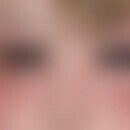Synonym(s)
HistoryThis section has been translated automatically.
DefinitionThis section has been translated automatically.
You might also be interested in
ClassificationThis section has been translated automatically.
Acquired cold urticaria:
- Contact type: On exposed parts of the body, especially face, neck and hands, formation of itchy erythema and wheals within a few minutes after exposure. Symptoms occasionally only after rewarming of skin areas. Regression within a few hours after cold exposure. Rarely purpura at the site of exposure. Extensive cold exposure (see also cold air urticaria and cold water urticaria) may cause systemic reactions such as headache, respiratory distress, hypotension. Care should be taken when consuming cold foods (ice cream) and beverages in patients with angioedematous reactions of the mucous membranes.
- Cold-induced cholinergic urticaria: Generalized wheal formation after exertion in a cold environment.
- Cold-dependent dermographism: Urticarial dermographism confined to areas that have been previously chilled
- Delayed-type cold urticaria: localized wheal formation 12-48h after cold exposure
- Systemic cold reflex urticaria: remote onset of urticaria after localized cold exposure
- Localized cold reflex urticaria: Urticarial reaction nearby but not directly at the site of exposure.
Familial disorders (Cold urticaria, familial (Familial cold-induced autoinflammatory syndrome 1-4 - FCAS1-4).
- "Cold-induced autoinflammatory syndrome, familial " (FCAS1) is a hereditary autoinflammatory syndrome caused by a heterozygous mutation in the NLRP3 gene (1q44). FCAS1 is clinically characterized by recurrent episodes (with repeated exposure) of urticarial exanthema associated with arthralgias, myalgias, fever and chills, and swelling of the extremities after exposure to cold. After decades of progression, in rare cases patients may also develop late-onset renal amyloidosis (Hoffman et al. 2000).
- "Cold-induced autoinflammatory syndrome 2, familial" (FCAS2; OMIM: 609648). Autosomal dominant syndrome 2 is caused by heterozygous mutations in the NLRP12 gene on chromosome 19q13.42.
- The autosomal-dominantly inherited "Cold-induced autoinflammatory syndrome 3, familial" (FCAS3), also called PLCG2-associated antibody deficiency and immune dysregulation (PLAID) is caused by heterozygous deletions in the PLCG2 gene on chromosome 16q23.
- " Cold-induced autoinflammatory syndrome 4, familial " (FCAS4), is associated with a heterozygous mutation in the NLRC4 gene (606831) on chromosome 2p22.
Occurrence/EpidemiologyThis section has been translated automatically.
EtiopathogenesisThis section has been translated automatically.
Often unexplained. Infections occur disproportionately in this group of patients (Helicobacter pylori, chronic tonsillitis, Borrelia infections, past viral infections: CMV, EBV, RSV, adenoviruses); their significance remains unclear at present.
Associations with malignant systemic diseases (malignant lymphomas, leukemias) have been described.
The clinical symptoms are triggered by activation and degranulation of cutaneous mast cells with consecutive release of histamine, leukotrienes and other proinflammatory mediators.
ManifestationThis section has been translated automatically.
Women are affected about twice as often as men. The median age of manifestation is about 20 years. On average, the duration of the disease can be expected to be 1-15 years. The median duration of the disease is 5 years.
LocalizationThis section has been translated automatically.
ClinicThis section has been translated automatically.
The clinical picture of cold urticaria is largely uniform and is also diagnostic based on the medical history (which must be very differentiated for the various types of urticaria). Itchy erythema and wheals develop on exposed parts of the body (rarely also remotely), especially on the face, neck and hands, within a few minutes (rarely delayed) after exposure.
Symptoms occasionally only appear after the skin areas have warmed up again. Regression occurs within a few hours after exposure to cold.
Purpura rarely occurs at the site of exposure.
Systemic reactions such as headaches, breathing difficulties and a drop in blood pressure may occur with extensive exposure to cold (see also cold air urticaria and cold water urticaria).
In general, symptoms caused by cold food (ice cream) or drinks can lead to systemic reactions.
Some people report urticarial reactions, which preferably occur after exposure to cold wind or evaporative cooling after sweating. The temperature difference is apparently more important here than the absolute temperature.
HistologyThis section has been translated automatically.
DiagnosisThis section has been translated automatically.
- Type of contact: Place a metal cylinder or test tube filled with ice water on top for 3-5 minutes.
- Reflex type: Double-sided cold arm bath (8-10 °C) for 10 to 20 minutes or cold partial bath (10-16 °C).
- If generalized cold urticaria is present, the patient must be exposed to cold room air (about 4 °C) for 10-20 minutes.
Differential diagnosisThis section has been translated automatically.
- FACS ( cold urticaria, familial)
- Other forms of familial cold urticaria (Familial atypical cold urticaria; Familial delayed-type cold urticaria).
- Cold panniculitis
- Pressure urticaria.
General therapyThis section has been translated automatically.
therapy of underlying diseases.
Education: The patient must be educated about general rules of behaviour, because in case of urticaria system reactions like tachycardia and dyspnoea up to anaphylactic shock can occur.
Therefore:
- No consumption of cold ice cream, cold drinks.
- No jumping into cold water.
- Avoid exposure to cold in the transitional seasons and in winter.
- Wear warming protective clothing/gloves.
- Protect face from cold, etc.
- "Hardening": attempt to adapt slowly to the cold by taking cold water showers every day. Good compliance is a prerequisite, as continuous and strictly regular daily maintenance therapy is necessary to avoid shock situations. Patients often do not adhere to the procedure.
Notice! Hardening" should only be initiated under stationary conditions due to possible shock reactions! The threshold temperature can be lowered considerably. However, the acceptance of this method is low.
Internal therapyThis section has been translated automatically.
In case of system reactions, therapy appropriate to the stage of the disease, see below Shock, anaphylactic. If an avoidance strategy is not sufficient, antihistamines are the therapy of choice.
H1-blockers: Symptomatic therapies with H1-blockers such as hydroxyzine (e.g. Atarax) 40 mg/day or cetirizine can have moderate success.
Alternatively, high-dose antihistamine therapy: In a small placebo-controlled study (30 patients), success with a high-dose antihistamine therapy (desloratadine 20 mg/day p.o.) was described. The study confirms the recommendations of the European professional societies to increase the dose if the standard therapy of a non-sedating antihistamine does not respond adequately.
Alternatively, immunosuppressive drugs ( Ciclosporin A) can be used in refractory cases.
Alternative: Omalizumab (Xolair): In a double-blind study a high response rate or complete remissions could be achieved with 150mg as well as 300mg of Omalizumab every 4 weeks s.c. Omalizumab should be an effective and well-tolerated therapy alternative (Metz M et al. 2017).
Other:
- Cromoglicic acid: Orally administered cromoglicic acid is ineffective.
- Penicillin: Penicillin G 10 million IU/day i.v. over 2-3 weeks (response rate according to literature 25-50% in patients with familial cold urticaria; according to own experience less successful).
- In individual cases successful therapies:
- DADPS (e.g. Dapson Fatol)
- Stanazole
- Hydroxychloroquine (e.g. Quensyl)
- β 2 -Sympathomimetics (e.g. terbutaline or bambuterol) in combination with theophylline (e.g. afonilum or euphylong).
TablesThis section has been translated automatically.
Classification of cold urticaria
Classification |
Localized reactions to cold |
Instant cold urticaria |
|
delayed-type cold urticaria | |||
cold-dependent urticaria factitia | |||
localization-dependent cold urticaria | |||
localized cold reflexurticaria | |||
perifollicular cold urticaria | |||
familial cold urticaria of the delayed type | |||
| |||
cold urticaria (special forms) |
cholinergic cold urticaria |
||
familial cold urticaria (synonym: familial polymorphic cold reaction) | |||
| |||
Associated diseases |
Instant type reactions |
Urticaria |
urticaria factitia |
cholinergic urticaria | |||
Thermal urticaria | |||
aquagenic urticaria | |||
Light urticaria | |||
Food allergies | |||
exercise-dependent asthma | |||
Insect bite reactions | |||
Jellyfish poison reactions | |||
| |||
Infectious Diseases |
Diseases caused by spirochetes (syphilis, borreliosis) |
||
Measles | |||
Varicella | |||
Hepatitis | |||
infectious mononucleosis | |||
HIV infection | |||
| |||
Diseases with abnormal serum proteins |
Cryoglobulinemia (primary) |
primary cryoglobulinemia |
|
Cryoglobulinemia (secondary) |
Chronic lymphatic leukemia |
||
Plasmocytoma | |||
Lymphosarcoma | |||
leukocytoclastic vasculitis | |||
angioimmunoblastic lymphadenopathy | |||
Macroglobulinemia | |||
Cryofibrinogenesis |
collagenoses, hematological diseases, neoplasias |
||
cold hemolysins |
Late syphilis, syphilis connata |
||
C2 andC4 defects | |||
LiteratureThis section has been translated automatically.
- Bonadonna et al (2003) Treatment of aquired cold urticaria with cetirizine and zafirlukast in combination. J Am Acad Dermatol 49: 714-716
- Buss Y et al (2005) Kälteurtikaria: Investigation of causes, therapy and course. Allergology 28: 483-490
- Frank JP (1792) De curandis hominum morbis epitome. Liber 3, De exanthematibus, Mannheim, Swan, p. 104
- Ito A et al (2003) Purpura with cold urticaria in a patient with hepatitis C virus infection-associated mixed cryoglobulinemia type III: successful treatment with interferon-beta. J Dermatol 30: 321-325
- Jabbour SA (2003) Cutaneous manifestations of endocrine disorders: a guide for dermatologists. At J Clin Dermatol 4: 315-331
- Krause K et al (2010) Cold induced wheals and angioedema. Dermatologist 61: 743-749
- Marsland AM et al (2003) Cold urticaria responding to systemic ciclosporin. Br J Dermatol 149: 214-215
- Metz M et al (2017) Omalizumab is effective in cold urticaria-results of a randomized placebo-controlled trial.J Allergy Clin Immunol 140:864-867.
- Möller A et al (1996) Epidemiology and Clinic of Cold Urticaria. dermatologist 47: 510-514
- Krause K et al (2010) Cold induced wheals and angioedema. Dermatologist 61: 743-749
- Marsland AM et al (2003) Cold urticaria responding to systemic ciclosporin. Br J Dermatol 149: 214-215
- Möller A et al (1996) Epidemiology and Clinic of Cold Urticaria. Dermatologist 47: 510-514
- Raap U et al (2004) New therapeutic options for urticaria and its subtypes. Dermatologist 55: 361-366
- Siebenhaar F et al (2009) High dose Desloratadin decreases volume and improves cold provocation tresholds compared with stadard-dose treatment in patients with acquired cold urticaria; a randomized, placebo-controlled, cross-over study: J Allergy Clin Immunol 123: 672-679
- Trevisonno J et al (2015) Physical urticaria: Review on classification, triggers and management with special focus on prevalence including a meta-analysis. Postgrade Med 127:565-570
Incoming links (20)
Cold air urticaria; Cold-contact urticaria; Cold reflexurticaria; Cold water urticaria; Cryoglobulins and skin; Cryopathies; Cryoproteinemia; Cryourticaria; Dermadrome; Familial cold autoinflammatory syndrome 4; ... Show allOutgoing links (23)
Anaphylactic shock; Angioedema (overview); Antihistamines, systemic; Beta2 sympathomimetics; Cetirizine; Ciclosporin a; Cold air urticaria; Cold panniculitis; Cold water urticaria; Dadps; ... Show allDisclaimer
Please ask your physician for a reliable diagnosis. This website is only meant as a reference.









